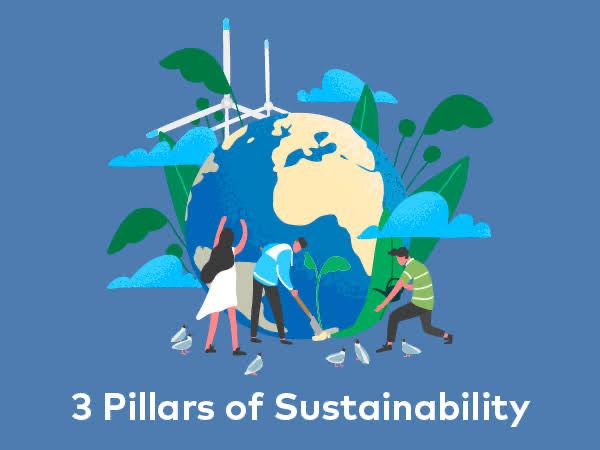Sustainability reminds us that there’s another way of doing things or is most often defined as meeting the needs of the present without compromising the ability of future generations to meet theirs. Sustainability is based on a simple principle: Everything that we need for our survival and well-being depends, either directly or indirectly, on our natural environment and those are finite resources and so should be used conservatively and carefully to ensure that there is enough for the future generations, without decreasing present quality of life. A company implements sustainable practices by reducing its consumption of limited resources or finding alternative resources with lower environmental consequences.
Why is Sustainability Important?
The National Environmental Policy Act of 1969 committed the United States to sustainability, declaring it a national policy “to create and maintain conditions under which humans and nature can exist in productive harmony, that permit fulfilling the social, economic and other requirements of present and future generations.”
There are many benefits to sustainability, both short-term and long-term. We cannot maintain our Earth’s ecosystems or continue to function as we do if more sustainable choices are not made. If we do not change ourselves and harmful processes are maintained with no change, it is likely that we will run out of fossil fuels, huge numbers of animal species will become extinct, and the atmosphere will be irreparably damaged. The construction process of traditional buildings alone emits much construction waste. Recyclability of materials, therefore, lessens negative emissions on the environment. Clean air and nontoxic atmospheric conditions, the growth of resources that can be relied upon, and more sustainability. Water quality and cleanliness, are all benefits of sustainability.
The Three Pillars of Sustainability
The three pillars of sustainability are a powerful instrument for defining the complete sustainability problem. This consists of the economic, social, and environmental pillars. If any one pillar is weak then the system as a whole is unsustainable.
The Environmental Sustainability:
Environmental sustainability is defined as responsible interaction with the environment to avoid depletion or degradation of natural resources like land, air, water, minerals, etc, and allow for long-term environmental quality. The practice of environmental sustainability helps to ensure that the needs of today’s population are met without jeopardizing the ability of future generations to meet their needs. Environmental sustainability, as described by Dunphy, Benveniste, Griffiths, and Sutton (2000) place emphasis on how businesses can achieve positive economic outcomes without doing any harm, in the short- or long-term, to the environment. According to Dunphy et al. (2000), an environmentally sustainable business seeks to integrate all four sustainability pillars, social sustainability, economic sustainability, environmental sustainability, and human sustainability and to reach this aim each one needs to be treated equally. The principle of the four pillars of sustainability states that for complete sustainability problems to be solved in relation to all four pillars of sustainability they need to be maintained.
When we look at the natural environment, we see that it has a rather remarkable ability to recharge and rejuvenate itself and sustain its viability. For example, when trees or leaves fall, they decompose and nurture the soil. These nutrients help sustain suitable conditions so future saplings can grow.
When nature is untouched and left alone, it has a tremendous ability to care for itself. However, when a man enters the picture and uses many of the natural resources provided by the environment, things change. Human actions can deplete natural resources, and without the application of environmental sustainability methods, long-term viability can be compromised.
Social Sustainability:
Social Sustainability is a very important factor in a community’s well-being and longevity. It includes environmental justice, human health, resource security, and education, among other important social elements of society. Under the three pillars concept, efforts to promote social sustainability should also aim to foster economic and environmental benefits, too. But unfortunately, Social sustainability is largely neglected in mainstream sustainability debates. Priority has been given to economic and environmental sustainability in particular in the context of planning, housing, and communities, where policy and investment have focused on renewable resources, low-carbon communities, and encouraging pro-environmental behavior in households. A community is composed of people as well as the places where they live; it is as much a social environment as a physical environment. Thus, communities must not only be environmentally sustainable, they must also be socially sustainable.
For business, companies that raise the importance of social sustainability recognize the significance of their relationships with people, communities, and society. Social responsibility becomes part of their core business strategy and they consider how their activities affect people. Companies put efforts to generate social sustainability could include focusing company efforts on employee retention instead of economic priorities. For example, investments in the well-being of employees are likely to generate economic benefits for the company by increasing employee motivation.
Economic Sustainability:
Economic sustainability includes job creation, profitability, and proper accounting of ecosystem services for optimal cost-benefit analyses. It is about conserving resources and the concept is used to define and explain the value resources have today and their possible value in the future. For example, the value can be explained with the help of indicators like added value, assets and debts, savings, patents, and intangible assets.
Economic sustainability is important for a business because it cannot achieve long-term growth if it exhausts natural or human resources. Business today can no longer harm the environment or their communities to deliver ongoing economic growth because continuing to do so creates conditions that destabilize the context in which the business operates. Economic sustainability delivers many advantages to businesses. For example, it helps them assess their operations to monitor things like energy waste, which leads to savings. And by enacting better social practices, companies avoid turnover and have a more productive staff. Being an economically sustainable business can help win contracts from clients and governments, and can increase customer loyalty.
Since the 1980s, when the three pillars were widely popularized, businesses, governments, and organizations have applied the pillars to their practices with variable success. Conceptually, true sustainability requires consideration of all three pillars.




 Each title in our collection is more than just a book - it’s a ‘green gift’, promoting mindful reading, sustainable values, and a culture of eco-conscious living. By gifting books, you open doors to new ideas, support lifelong learning, and nurture a more informed, compassionate, and environmentally aware individual.
Each title in our collection is more than just a book - it’s a ‘green gift’, promoting mindful reading, sustainable values, and a culture of eco-conscious living. By gifting books, you open doors to new ideas, support lifelong learning, and nurture a more informed, compassionate, and environmentally aware individual.